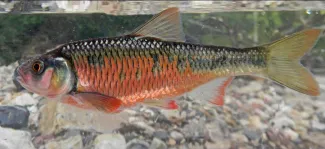Our wildlife resources are part of our natural heritage, along with the plant communities on which they rely. The Oklahoma Natural Heritage Inventory, a branch of the Oklahoma Biological Survey, collects information about our plants and animals and maintains a publicly accessible clearinghouse of records for the state.
How the Heritage Inventory Helps Wildlife
The Oklahoma Natural Heritage Inventory (ONHI) began in 1977 as a biological inventory of Oklahoma’s plant and animal diversity. Ten years later, ONHI was brought to the University of Oklahoma as part of the Oklahoma Biological Survey and its state-mandated mission to collect and house biodiversity data for the state.
ONHI biologists conduct field inventories to find and evaluate occurrences of rare species and communities throughout the state. Other sources of data are also collected. All data are housed within the Oklahoma Biodiversity Information System (OBIS), a database of approximately 400,000 records. Using those data, the biologists determine a species’ or community’s distribution, rarity, and threat risk in order to assign a conservation status ranking. Conservation ranks are assigned using an internationally recognized standard as developed by NatureServe, an umbrella organization of Natural Heritage Programs worldwide. Beneficiaries of ONHI efforts include state and federal agencies, researchers, and the citizens of the state of Oklahoma.

The striped shiner is just one of many species tracked by the Oklahoma Natural Heritage Inventory. (Brandon Brown/ODWC)
In addition, the Heritage Inventory manages the Oklahoma Natural Areas Registry, where they partner with landowners throughout Oklahoma to help conserve rare species on individual properties.
To help identify where conservation projects could start, the ONHI often provides information about our plants and wildlife to the Wildlife Department’s Wildlife Diversity Program. Other partners in conservation include the the U.S. Fish and Wildlife Service, NatureServe, The Nature Conservancy, and, among other museums across the state, the Sam Noble Oklahoma Museum of Natural History.
What’s New at the Heritage Inventory?
Beyond monitoring the conservation statuses of sensitive plants and animals in the state, ONHI biologists also have active research projects. Those projects include investigating the rarity, distribution, and ecology of land snails, tiger beetles, dragonflies, robber flies, and a variety of plants; examining the effects of historical land-use changes and droughts on plants and animals; conducting species distribution modeling; and vegetation classification and mapping. ONHI is also working to update their webpage to provide a more user-friendly environment to access information. Updates will include new species fact sheets and an interface to produce a list of species of conservation concern.
Help the Oklahoma Natural Heritage Inventory
If you see a rare species or one that is outside of its normal range, please let an ONHI biologist know. Record exactly where you saw the species and try to get a photo or write a detailed description of what you saw.